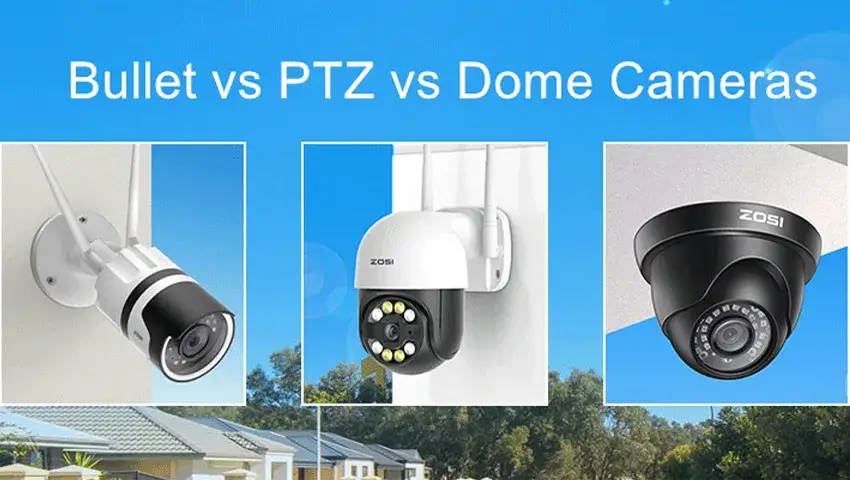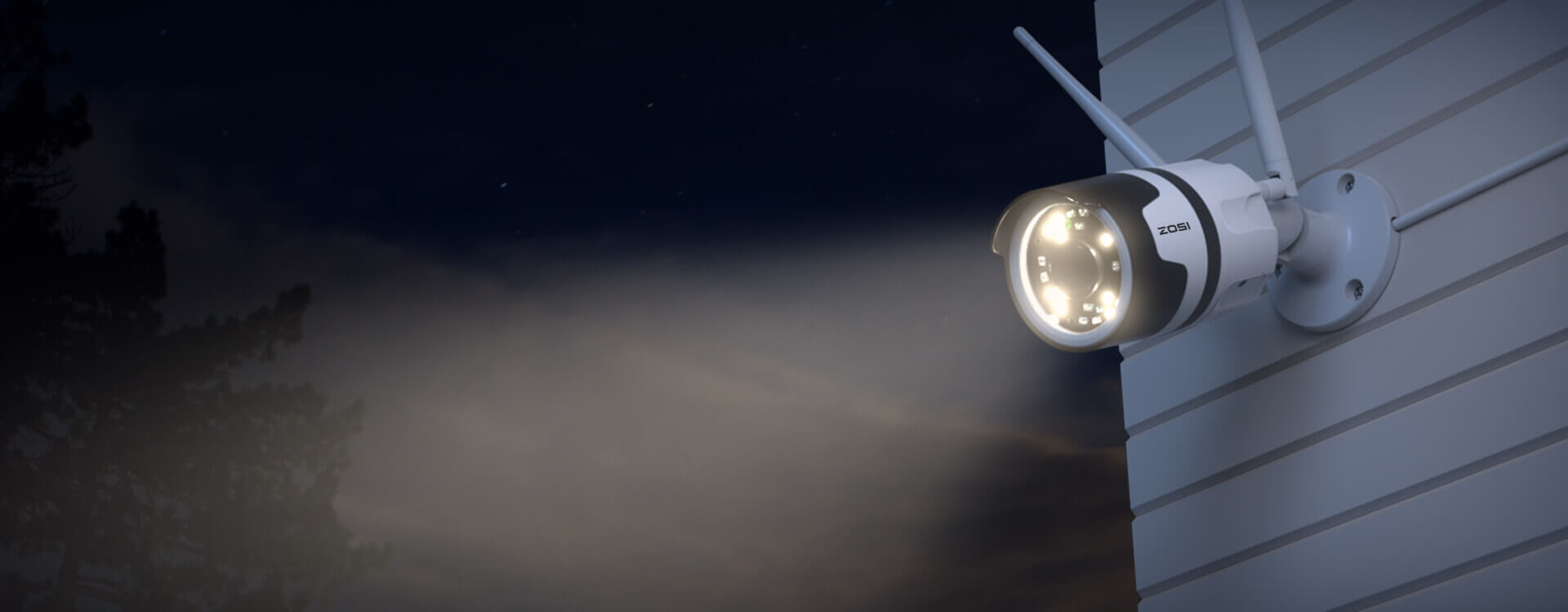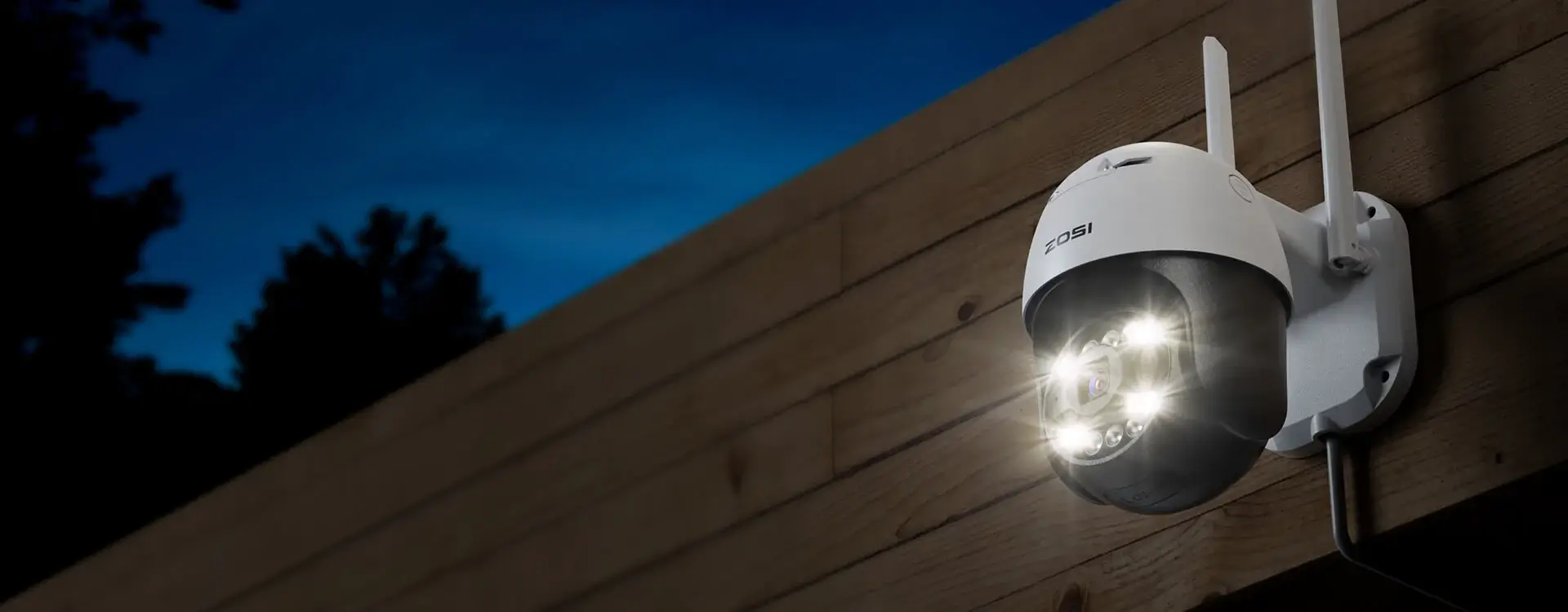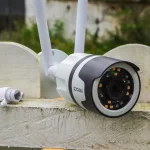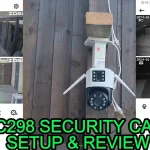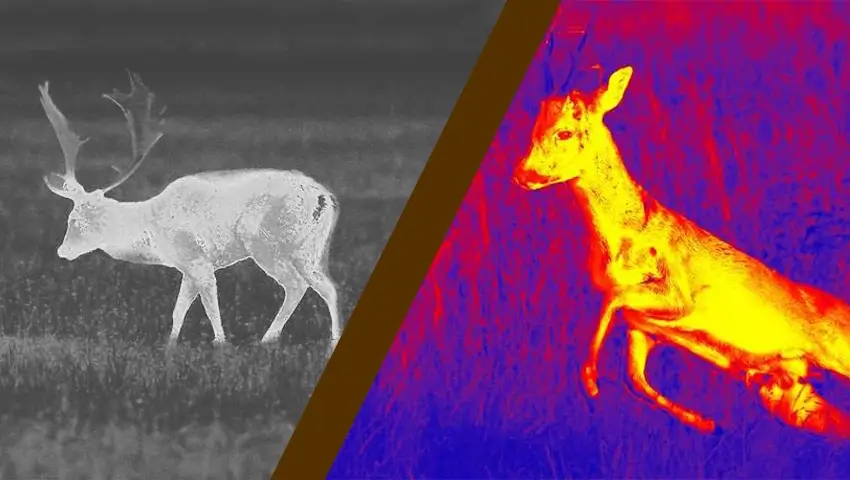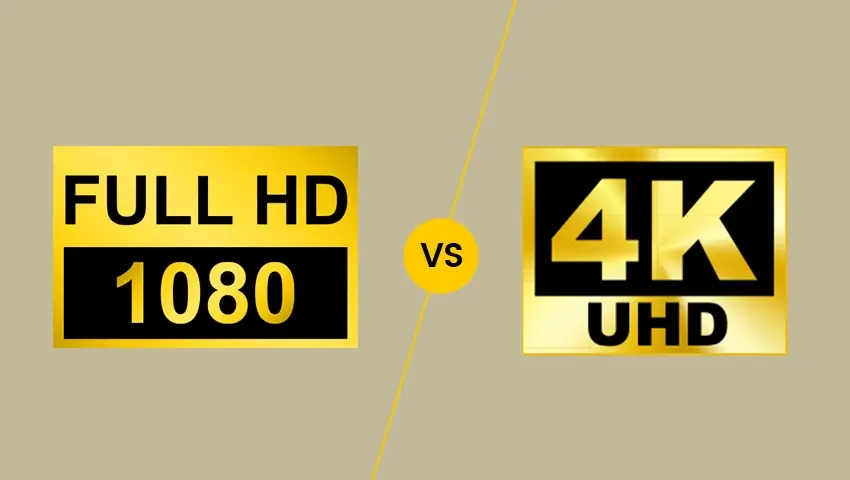What are the differences between bullet cameras, dome cameras and PTZ cameras? Bullet vs. dome vs. PTZ camera: which one to choose?
Understanding bullet, dome and PTZ camera benefits and limitations, therefore, is important in helping the user decide which one to choose.
Regardless of your property type (residential or business) and size, there are some subtle differences between the three security cameras that should know.
This article will address these concerns and specifically detail the definitions of Bullet vs Dome vs PTZ cameras alongside their benefits, limitations, and differences so that you can choose the one that’s most suitable for your business or your home.
Contents
Bullet, Dome & PTZ Cameras Definition
Before going into the main differences between Bullet Dome PTZ Security cameras, let’s first understand what each camera is, including their perks for business or home monitoring.
1. What Is a Bullet Camera?
This type of surveillance camera is designed to take the shape of a rifle bullet. Usually 2 to 8 inches long, these are generally the smaller of the bunch and are often pertained to as “lipstick cameras”. Moreover, these cameras have a variable or fixed focal length lens that’s especially useful for when you want to focus on particular spaces.

Main Bullet Camera Advantages:
- Cheaper in general (Check the best budget pick)
- Longer range
- Easy of installation
- Indoor & outdoor use
- Weatherproof
- Night Vision
2. What is the Dome Camera?
These cameras obtained their name because of their dome-like, circular shape. They’re also usually situated on the ceiling, under the soffit or eaves, either outdoors or indoors. While you can use dome cameras both ways, many restaurants or hotels opt for this device inside mainly due to their design.

Main Dome Camera Advantages:
- More discreet – blends in with surroundings
- Wide-angle
- Indoor & outdoor use
- Weatherproof
- Night Vision
- Vandal-resistant (IK10 rated ones)
3. What is a PTZ Camera?
Also known as a pan-tilt-zoom camera, this is a speed dome camera that’s great for zoom or remote directional control. Here, you can pan PTZ cameras left and right, tilt them up or down, and zoom in or out. Generally, PTZ cameras tend to be larger for outdoor usage with impeccable resolution.

Major PTZ Cameras Advantages:
- 360° pan, 0°~90° tilt to provide a larger field of view
- Optical zoom to see far-away objects clearly
- Most PTZ dome cameras capture high-quality images
Main Differences Between Bullet Cameras, Dome Cameras, and PTZ Security Cameras
While all three surveillance cameras can both be applied in your business or home purposes, many of their differences lie in several standards such as night vision, visibility, installation, view range, and more.
1. Location
The best locations for each type of camera largely depend on where they’re best installed.
Here is a table showing the differences between the common and best installation places of the bullet, dome, and PTZ dome cameras.
| Comparison | Common installation locations |
| Bullet cameras | The walls of the front door, backyard, off-street windows or anywhere outdoors |
| Dome cameras | Under the ceilings indoors, and under the eaves or the soffit outdoors |
| PTZ cameras | The second floor outdoors, construction sites for a wider view or very large indoor areas (supermarkets, airport, etc) |
For bullet surveillance cameras, the best location is usually in any area outdoors like your backyard, front door walls, windows or more. They’re the most suitable choice among the three if you want an outdoor security camera. This is because bullet security cameras not only have a better range for large backyards or parking spaces but are also fairly weatherproof at the same time.
Dome cameras tend to be installed indoors under ceilings or eaves or outdoors on the soffit. Unlike bullet cameras, these are best placed indoors because of their sleek and non-intrusive design. Furthermore, they also err on aesthetics and blend in with most indoor decorations.
On the other hand, you can place PTZ cameras on second floors situated outdoors. Like bullet cameras, these are generally used outdoors or in spacious indoor areas because of their capability in catching wider fields of vision than the other types.
Whether you choose bullet or dome cameras, it is very important for you to plan the security camera placement ahead, so they can do the best job.
2. Field of View
Among the three, the PTZ cameras generally have the widest field of view because they are specifically designed for larger areas. These cameras support an approximate 360 degrees horizontal and 90 degrees, or even a vertical rotation of about 180 degrees. Meanwhile, both dome and bullet cameras have a fixed field of view of about 70 to 100 degrees.
Nonetheless, the view and range of these cameras can be influenced by different factors such as the kind of lens, sensor chips, and more. Because of this, it’s always better to consult the specifics of the camera so that you learn each type’s accurate viewing field.
Bullet vs. Dome vs. PTZ CCTV Cameras in FOV
| Comparison | Camera view |
| Bullet cameras | 70°-100° |
| Dome cameras | 70°-100° |
| PTZ cameras | 360° endless pan & 90° tilt |
3. Camera Visibility
CCTV bullet vs. dome cameras (PTZ cameras included), which one is easier to hide?
Comparing the size of the dome, bullet and PTZ CCTV cameras may give you a clue.
PTZ vs. Bullet Type vs. Dome Camera in Size
| Comparison | Camera size |
| Bullet cameras | 2-8 inches |
| Dome cameras | About 4 inches |
| PTZ cameras | About 8 inches |
When talking about visibility, bullet cameras are the most obvious because of their shape and size range of about 2-8 inches. For this, they can be a suitable option if you want to discourage vandals or burglars from invading your home. However, keep in mind that its evident visibility can also prompt thieves to damage them if they’re determined enough to break into your premises.
Dome cameras, which are about 4 inches in size, are a bit harder to see and are an excellent choice if you plan on keeping them discreet, away from the attention of people. PTZ cameras are generally larger at 8 inches and are mounted in a high place away from people’s reach so that they can catch a larger field of view.
Click to learn more about how to hide security cameras indoors and outdoors here.
4. Night Vision
Although most bullet, dome, and PTZ surveillance cameras have infrared LEDs to create their own light when there is none, the night vision cameras vary from short night vision distance to long one.
Unlike dome and bullet cameras that only have a 100ft night vision range, PTZ cameras are extraordinary when it comes to long-distance night vision because they have more LED lights.
PTZ vs. Bullet vs. Dome Surveillance Camera in Night Vision
| Comparison | Night vision range |
| Bullet cameras | 100ft |
| Dome cameras | 100ft |
| PTZ cameras | 190ft |
5. Installation
PTZ and bullet cameras are generally easier to install since they come with a bracket and a mounting handle, making attaching them to the wall convenient. Once you’re finished installing them, you can move them to conceal any area that you want.
On the other hand, dome cameras typically need more effort for installation. Here, you’d have to unscrew the camera from its mounting house, situate the housing on your wall, and fixate the dome camera in the designated wall.
Buying Guide: Bullet Cameras VS Dome Cameras VS PTZ Cameras
After seeing the differences between bullet cameras, dome cameras, and PTZ cameras, you may ask what is best, a dome camera or bullet.
Here is an overview of the difference between the PTZ and fixed cameras (dome and bullet type) to help you reach a final decision.
| Comparison | Bullet cameras | Dome cameras | PTZ cameras |
| Installation location | On the wall | Under the ceilings, eaves | Higher places like the second-floor level |
| Camera view | 70°-100° | 70°-100° | 360° endless pan & 90° tilt |
| Night vision | About 100ft | About 100ft | About 200ft |
| Visibility (size) | 2-8 inches | About 4 inches | About 8 inches |
| Indoor or outdoor | Mostly outdoors | Indoors or outdoors | Mostly outdoors |
You can choose the most appropriate type depending on your needs:
Would you like to install it outdoor, or indoor? Do you use it for a home office? What about the light conditions? How large is the detected area?
Think about these questions before making the decision of bullet or dome IP cameras.
And here I’ll recommend the best pick in each category if you want a quick decision.
1. Best Bullet Security Camera: C190 Pro
At a reasonable price, the C190 pro can be a trustworthy surveillance camera when it comes to detecting and alerting you of any potential danger within your premises. Its excellent features, such as Smart AI human detection and light and sound alarm, prove useful in keeping unprecedented troubles away.
Not only that, but it also comes with customizable advanced motion detection that notifies you via the ZOSI app for any unexpected movement. Moreover, its high-efficiency video compression keeps the video at high quality even with a low-bitrate, thereby allowing you to maximize storage space for long recordings.
Smart 3MP Super HD WiFi Security Camera - C190
- 2.4/5 GHz WiFi
- Light & Siren Alarm
- Color Night Vision
- AI Human Detection
- 2-Way Audio
Key features:
- 5MP Super HD
- Excellent IR night vision to capture thieves in low-light night vision
- Smart motion detection alerts you if anything happens
- Easy to install (plug and play)
- IP66 waterproof rating for outdoor uses
2. Best PTZ Surveillance Camera: C289
The ZOSI C289 camera is equipped with advanced security features that can help put your worries to rest. With this, you can get smart alerts through AI human detection, which helps distinguish unauthorized people from other moving objects. It also comes with a clear two-way talk via a noise-canceling microphone and speaker that allows you to communicate with your families or friends to warn them off from potential home invaders.
More than that, the C289 also supports preset point and automatic cruise. Once you turn on this function, the camera will then patrol around automatically. You can also opt to preset cruise points so that your surveillance camera can patrol customized pathways or specific sports that need extra monitoring.
C296 - Pan Tilt IP Security Cameras
- 4K Ultra HD/5MP Super HD
- Starlight Color Night Vision
- Pan & Tilt
- PoE/WiFi Connection
- Light & Siren Alarm
- Upgraded AI-Powered Detection
- 2-Way Audio
Key features:
- 3MP resolution offers the best chance to see every image details
- 275° endless pan and 90° tilt
- 100ft long-range IR night vision
- IP65 waterproof rating for outdoor uses
Bullet vs. Dome vs. PTZ Cameras Questions to Consider
To select the best camera for your application, there are several things to consider:
- What does my customer want to achieve? If it’s intrusion detection, consider a bullet camera. Area surveillance can be achieved by dome cameras. Target tracking is best for PTZ cameras. If aesthetics are important, dome cameras may be preferred.
- Which areas need surveillance coverage? Bullet cameras are suited for perimeters and fence lines. Dome cameras are sufficient for outdoor courtyards, entrance gates and large indoor spaces. PTZ cameras are optimal for outdoor corridors, hallways, and large sites requiring 180- or 360 scans of the entire area.
- What range does my customer need to achieve for recognition and detection? Remember, bullet and PTZ cameras have longer ranges than dome cameras. They will be able to classify targets at further distances.
Conclusion
There’s Not a Lot of Difference Between Bullet, PTZ and Dome Cameras
We recommend using bullet cameras outdoors because Bullet Security Cameras are easier to install on a wall (which is usually how you install an outdoor camera) and usually have a bit more distance.
Use dome cameras indoors as they are easier to install on the ceiling (which are usually inside) and usually have more of a wide viewing angle.
If you need a larger viewing angle, then the PTZ camera is your best choice
Avoid Dome Cameras with Glass Domes, unless you’re facing a lot of vandalism and you need a protective glass dome, a bullet or a PTZ camera is just easier to install. Dome cameras have a much higher rate of installation mistakes.
